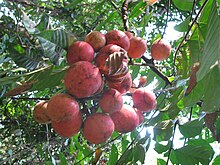
Mahogany is a straight-grained, reddish-brown timber of three tropical hardwood species of the genus Swietenia, indigenous to the Americas and part of the pantropical chinaberry family, Meliaceae. Mahogany is used commercially for a wide variety of goods, due to its coloring and durable nature. It is naturally found within the Americas, but has also been imported to plantations across Asia and Oceania. The mahogany trade may have begun as early as the 16th century and flourished in the 17th and 18th centuries. In certain countries, mahogany is considered an invasive species.
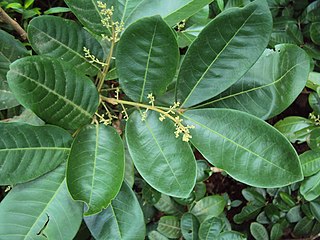
Aglaia is a genus of 121 recognised species of woody dioecious trees in the mahogany family Meliaceae. They occur in the subtropical and tropical forests of Southeast Asia, northern Australia and the Pacific.

Toona, commonly known as redcedar, toon or toona, tooni is a genus in the mahogany family, Meliaceae, native from Afghanistan south to India, and east to North Korea, Papua New Guinea and eastern Australia. In older texts, the genus was often incorporated within a wider circumscription of the related genus Cedrela, but that genus is now restricted to species from the Americas.

The Sapotaceae are a family of flowering plants belonging to the order Ericales. The family includes about 800 species of evergreen trees and shrubs in around 65 genera. Their distribution is pantropical.

Azadirachta is a genus of two species of trees in the mahogany family Meliaceae. Numerous species have been proposed for the genus but only two are currently recognized, Azadirachta excelsa and the economically important tree Azadirachta indica, the neem tree, from which neem oil is extracted. Both species are native to the Indomalaysian region, and A. indica is also widely cultivated and naturalized outside its native range.

Entandrophragma is a genus of eleven known species of deciduous trees in the family Meliaceae.

Synoum is a monotypic genus of evergreen tree in the family Meliaceae. It is endemic to Australia where it is found along the eastern sub-tropical to tropical coast, usually on the margins of rainforests, in Queensland and New South Wales.

Dysoxylum is a genus of rainforest trees and shrubs in the flowering plant family Meliaceae. About 34 species are recognised in the genus, distributed from India and southern China, through southeast Asia to New Guinea, Solomon Islands, and Australia. The name Dysoxylum derives from the Greek word ‘Dys’ meaning "bad" referring to "ill-smelling" and ‘Xylon’ meaning "wood".
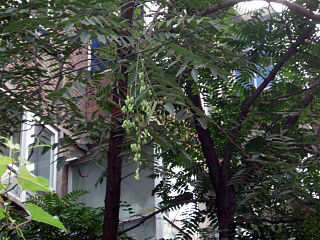
Toona sinensis, commonly called Chinese mahogany, Chinese cedar, Chinese toon, beef and onion plant, or red toon is a species of Toona native to eastern and southeastern Asia, ranging from northern Korean peninsula through most of eastern, central, and southwestern China, in Nepal, northeastern India, Burma (Myanmar), Thailand, and even present in Malaysia and western Indonesia.
Pseudocarapa is a genus of flowering plants in the family Meliaceae. It includes five species which range from Sri Lanka to Sumatra, Peninsular Malaysia, Borneo, and New Guinea.
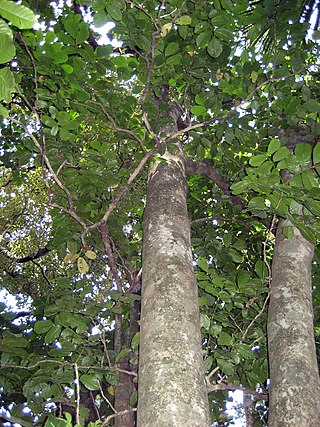
Didymocheton is a genus of flowering plants in the family Meliaceae. It includes 41 species which range from eastern India through Indochina and southern China to Malesia, Papuasia, eastern Australia, New Zealand, and the South Pacific.
Prasoxylon is a genus of flowering plants in the family Meliaceae. It includes seven species which range from Nepal and eastern India through Indochina to southern China, Taiwan, Malesia, Sri Lanka, Papuasia, and Queensland.
PtaeroxylaceaeJuss. are a small family of Southern African indigenous trees and woody lianes, most of them from Madagascar, comprising only two genera. Such a family was not recognized by the APG II system of classification (2003), which noted that it was a synonym of Rutaceae. The APG III system of 2009, an updated version of the last system, did not mention the family. All species within this family are included within Rutaceae.

Toona sureni is a species of tree in the mahogany family. It is native to South Asia, Indochina, Malesia, China, and Papua New Guinea. It is commonly known as the suren toon, surian, limpaga, iron redwood or the red cedar. It is also known as the Indonesian mahogany or the Vietnamese mahogany. The species is a valuable timber tree.
Prasoxylon alliaceum is a tree in the family Meliaceae. The specific epithet alliaceum is from the Latin meaning "onion-like", referring to the smell of the inner bark.

Epicharis parasitica, commonly known as yellow mahogany, is a species of rainforest tree in the family Meliaceae native to Taiwan, parts of Malesia, Papuasia, and northeast Queensland.
Lepidotrichilia is a genus of flowering plants belonging to the family Meliaceae.
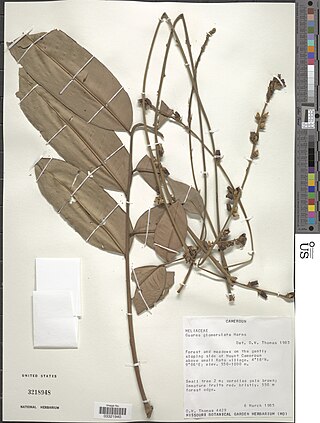
Neoguarea glomerulata is a species of flowering plant in the family Meliaceae. It is a tree or shrub native to west-central tropical Africa, ranging from southern Nigeria through Cameroon, Equatorial Guinea, Gabon, Republic of the Congo, and Democratic Republic of the Congo. It is the sole species in genus Neoguarea. It grows in lowland Guineo-Congolian rainforest.
Epicharis is a genus of flowering plants in the family Meliaceae. It includes seven species which range from Indochina to south-central China, Taiwan, Malesia, Papuasia, Queensland, and Fiji.

